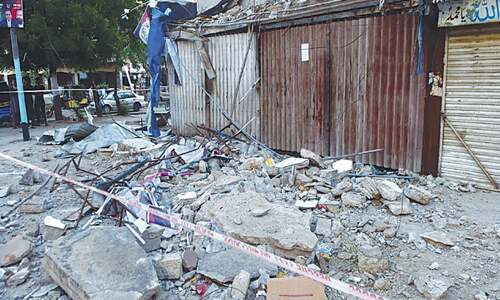KARACHI: There are quite a few definitions of architecture but the seminar organised by the Aga Khan Award for Architecture in collaboration with the Aga Khan University on Friday was based on the theme ‘architecture is life’. And understandably so.
The seminar formally commenced with Aga Khan University President Firoz Rasul’s welcome address. He said the event was significant because architecture was an important part of our lives and because it helped share knowledge — of projects, technologies, ideas, etc — which was also the basis of any university. He disclosed that the AKU planned a graduate school of architecture and human settlement.
Then the Institute of Architects, Pakistan presented a citation to His Highness the Aga Khan expressing its deep sense of gratitude and appreciation for his immeasurable contribution in different fields across the globe. The citation was accepted by Ms Rasul on His Highness’ behalf.
Hasan-Uddin-Khan, professor of architecture and historic preservation, Roger Williams University, who was the chief guest on the occasion, went down memory lane recalling the time when the first award ceremony was held in 1980 at the Shalimar Gardens, Lahore. He said initially it was thought that the award be called the Aga Khan Award for Islamic Architecture but that would’ve implied that it had only to do with the past, whereas architecture dealt with contemporary designs as well. A more inclusive approach meant many interpretations would begin to make sense. “Islamic architecture is the architecture of humanism,” he remarked touching upon the pluralistic expression of the art form.
Mr Khan told the audience that there were so far four winners from Pakistan: Tomb of Shah Rukn-i-Alam, Multan, Bhong Masjid, Rahim Yar Khan, Khuda Ki Basti, Hyderabad and Al Hamra Arts Council, Lahore. This led him to comment, “Architecture is not about buildings, it is about people.”
Farrokh Derakhshani, director of the Aga Khan Award for Architecture, highlighted the philosophy behind instituting in 1977 the award that was to have a long-term positive impact on people’s lives and to promote excellence in the field of architecture. Essentially it’s about society, about the general public, the creation of knowledge and being international, he said. “The philosophy hasn’t changed, yet it remains relevant,” he mentioned.
About the five winners of the 2013 cycle, he said their criteria for excellence was process, use of sources, identity, innovation and lesson learned.
Three successful 2013 projects were talked about in the first session of the seminar and two in the other, each followed by a panel discussion.
Tariq Qaiser introduced the Salam Centre for Cardiac Surgery in Khartoum. Yawar Jilani spoke on the Altach Islamic Cemetery, Austria and Shahnaz Arshad informed the attendees on the Rabat-Sale Urban Infrastructure Project, Morocco. While highlighting the Rabat-Sale piece, Ms Arshad drew its parallel with Lahore’s Bus Rapid Transit, delineating both similarities (historic context, social infrastructure) and dissimilarities (engineers leading the team in Lahore, sensitivity to heritage assets, etc). This prompted a sharp response from architect Nayyar Ali Dada during the panel discussion. He sarcastically said both projects were done by monarchies. He, however, was all praise for the three winners, saying that he was fascinated by the Altach Cemetery.
The discussion was very nicely conducted by Dr Suha Ozkan and participated by, apart from Mr Dada, Gulzar Haider, Farhat Abbas, Hanif Kara and Raul Pantaleo (architect of the Salam Centre for Cardiac Surgery).
In the post-lunch session, moderated by Hasan-Uddin-Khan, Marvi Mazhar introduced the Revitalisation of Birzeit Historic Centre, Palestine and Fauzia Qureshi apprised the audience about the Rehabilitation of Tabriz Bazaar, Iran. Ms Mazhar focused on the history of the revitalised centre with a local context, comparing it with old Karachi. Ms Qureshi did the same drawing into the debate the restoration work done in Lahore (walled city) and Multan’s historic areas.
The panel discussion that ensued was perhaps the liveliest part of the day.
Mohammad al-Asad summed up the session by underscoring the marked features of all the five winning projects.
Structural engineer Hanif Kara’s lecture on the topic of ‘Engineering Disobedience’ was the last item on the programme list. He laced his presentation with humorous one-liners by describing the relationship between architects and engineers in the context of modern-day technological developments and the use of materials.
An exhibition of 20 projects presented in 15 countries shortlisted for the 2011-2013 Aga Khan Award cycle was also visited by participants in the seminar.
The show will be open to the public from Nov 9 to 16 at AKU’s Sports Centre.
Published in Dawn, November 8th, 2014















































Dear visitor, the comments section is undergoing an overhaul and will return soon.